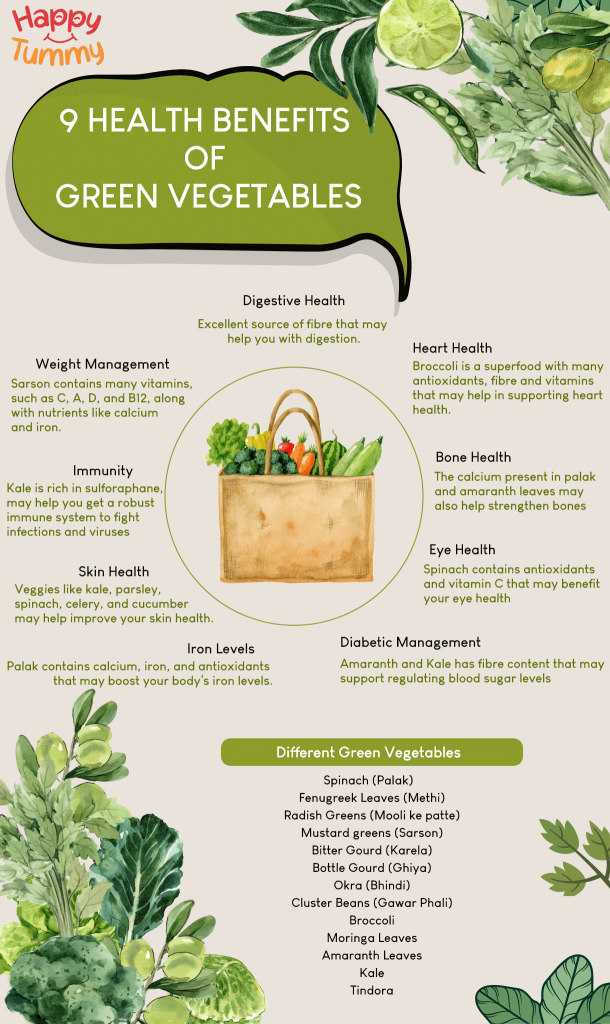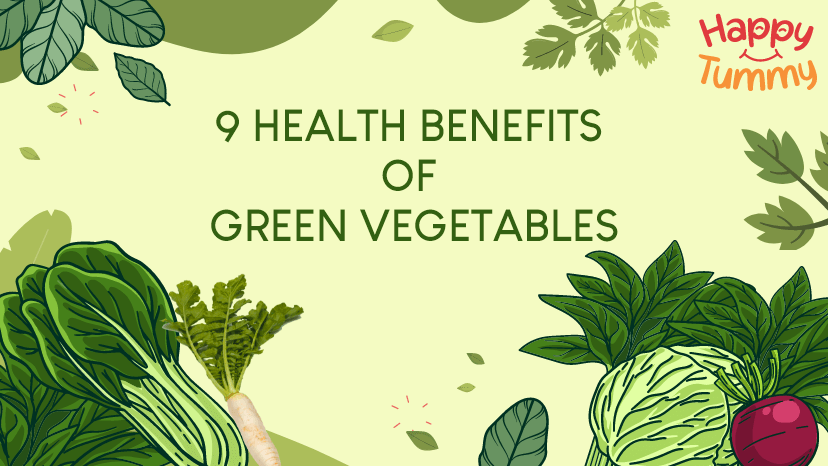Table of Contents
Green vegetables significantly contribute to health and are frequently hailed as nutritional powerhouses.
Leafy greens like spinach and kale, crisp broccoli, and cabbage are rich in nutrients and full of colour. They are just a few of the many green vegetables to include in your diet.
They are abundant in vital vitamins, minerals, fibre, and antioxidants. Thus, they may enhance the immune system, facilitate better digestion, encourage weight reduction, and lower the risk of chronic illnesses.
Including more green vegetables in your diet is not only a delightful option but may also be a step toward reaching maximum health and well-being because of its unrivalled nutritional profile and culinary diversity.
Different Green Vegetables
Green vegetables are a powerhouse of nutrients and may support health in many ways. Some examples of these vegetables are:
- Spinach (Palak)
- Fenugreek Leaves (Methi)
- Radish Greens (Mooli ke patte)
- Mustard greens (Sarson)
- Bitter Gourd (Karela)
- Bottle Gourd (Ghiya)
- Okra (Bhindi)
- Cluster Beans (Gawar Phali)
- Broccoli
- Moringa Leaves
- Amaranth Leaves
- Kale
- Tindora
Health Benefits of Eating Green Vegetables

These delicious and healthy vegetables offer numerous health benefits. Let’s find them out below.
#1. Digestive Health
Most green veggies are packed with essential nutrients, including fibre [1] that may support the proper facilitation of the digestion process.
Adding green veggies, such as green beans, spinach, kale, and broccoli, may provide a good amount of fibre that may be helpful for your digestive health [2].
Broccoli, especially, is rich in a plant compound called sulforaphane that may help improve your bacterial gut flora [3].
You may also include rajgira or amaranth leaves, as they are easily digestible and loaded with dietary fibre [4].
There are many ways of including these veggies in your diet to get the fibre content. To learn how much fibre there will be in your recipe, refer to My Meal Plan by Aashirvaad Atta.
Besides, you can also score your tummy by taking a quick Digestive Quotient Test and determine how well it is performing.
Top Recommendation: You can add kale and spinach to your diet, specifically for digestive health. These veggies are good for overall digestive health and gut flora.
#2. Heart Health
Broccoli is an amazing green vegetable with many health advantages. This vegetable is a superfood with many antioxidants, fibre and vitamins that may help in supporting heart health.
It also has anti-inflammatory and cardiovascular properties, which may be good for your heart [5].
Rajgira or amaranth leaves contain essential nutrients like potassium, iron, and vitamin C. These leaves also contain tocotrienols, a vitamin E that may help lower cholesterol levels [6].
You may also want to include cabbage for a healthy heart. It contains insoluble fibres that may support your overall heart health.
Besides, it is also potassium-rich food that may help lower blood pressure [7].
#3. Bone Health
You may include cabbage in your diet for your bone health. This vegetable contains a good amount of vitamin K that may help improve bone strength [8].
This vitamin may also help prevent bone fractures and help our bodies fight bone breakdowns. The calcium present in palak and amaranth leaves may also help strengthen bones [9].
Top Recommendation: Add palak and amaranth to your diet as they are really good for bones.
#4. Eye Health
Spinach, or palak, is a fantastic vegetable for your eye health. This nutrient-dense green vegetable contains antioxidants and vitamin C that may benefit your eye health [10].
Kale is another vegetable rich in carotenoids, lutein, and zeaxanthin that may help improve vision [11].
You may also get a good amount of vitamin A from amaranth leaves and vitamin E, which may support healthy vision.
#5. Skin Health and Delayed Ageing
Veggies like kale, parsley, spinach, celery, and cucumber may help improve your skin health. These veggies may help get a gorgeous and blemish-free glow on your face.
The antioxidants present in spinach may help in promoting healthy and glowing skin [12]. Besides palak, you may also add green beans for healthy skin as they contain a good amount of vitamins A and C.
Overall, green vegetables might also clean arteries, thereby supporting clear skin.
#6. Weight Management and High Antioxidant
Green veggies are considered excellent for anyone who plans to lose some weight [13]. Most green veggies are low in calories and high in antioxidants.
Sarson is one such veggie that is consumed the most in winter. It contains many vitamins, such as C, A, D, and B12, along with nutrients like calcium and iron that may help be your good companion for weight loss [14].
Amaranth leaves are low-fat and low-calorie food that may help you manage weight [15]. Similarly, tinda is a low-calorie ingredient that may help you manage your weight.
The fibre content in both amaranth and tinda may keep you full for a long time and reduce food cravings; hence, it may help you achieve and maintain adequate body weight.
You can always contact our expert dieticians to create a tailor-made diet plan for yourself.
#7. Immunity and Energy
Like broccoli, kale is another Brassica family vegetable rich in sulforaphane, a plant-based compound. This compound may help you get a robust immune system to fight infections and viruses [16].
Another green veggie that may help boost your immune system is green beans. These beans contain vitamins A and C, which are essential for fighting infections and diseases [17].
Spinach and amaranth leaves are other wonderful vegetables that may help boost your immune system as they contain vitamin A and C [18] [19].
#8. Diabetic Management
Amaranth and Kale are two amazing green veggies that may be added for blood sugar regulations. The fibre content in both these green veggies may support regulating blood sugar levels [20] [21].
#9. Iron Levels
Adding palak to your diet may help you increase haemoglobin levels. This vegetable contains calcium, iron, and antioxidants that may boost your body’s iron levels. You can add beetroot and moringa as their high iron values can support overall body functioning.
Spinach may be a great addition to a pregnant woman’s diet as it may help in increasing the iron levels that are needed during pregnancy [22].
Benefits of Green Vegetables for Men and Women
Let’s look at some general benefits of these delicious vegetables for men and women.
| Benefits | How it Supports Men | How it Supports Women |
| Digestive Health | Spinach may provide adequate fibre for healthy digestion. | Veggies like broccoli contain plant compounds that may support bacterial gut flora. |
| Bone Health | Cabbage contains essential vitamins that may help prevent bone fractures. | Cabbage contains vitamin K, which may promote healthy bones. |
| Skin Health | Kale, spinach, and cucumber may help improve skin health. | Antioxidants of spinach may help with healthy skin. |
| Immune System | Sulforaphane present in kale and broccoli may help in fighting infections. | Vitamins A and C in green beans may promote a healthy immune system. |
| Heart Health | Rajgira or amaranth leaves contain tocotrienols, a vitamin E that may help lower cholesterol levels. | Cabbage contains insoluble fibre and is potassium-rich, which may help lower blood pressure. |
| Iron Levels | Spinach has antioxidants that may boost iron levels. | Spinach may be a great addition during pregnancy as it increases haemoglobin levels [23]. |
Recipes to Make Green Vegetables
Here are a few dishes that you can try with green veggies:
- Palak Paneer
- Soups – mix different greens like broccoli and palak for enhanced taste and flavour.
- Salads
- Juices
- Smoothies
- Pesto – made from spinach
- Chips – kale and spinach
- Sarson ka saag
- Methi paratha – for added nutrition, make this paratha using Aashirvaad atta with multigrains.
- Curries
- Sabzis
- Dals
Sauteed Tindora Recipe
Ingredients:
- Tindora – ½ kg
- Mustard seeds – 1 teaspoon
- Red chilli powder – ½ teaspoon
- Coriander or South Indian curry powder – ½ teaspoon
- Salt – as per taste
- Coconut oil – 1 tablespoon
Method:
- Chop both ends of the tindora and cut in 4 pieces lengthwise.
- In a pan, heat oil and add mustard seeds.
- Once they crackle, add tindora and salt.
- Place a lid and cook for 10 minutes while stirring in between.
- Add chilli powder and coriander or South Indian curry powder.
- Saute for a couple of minutes and serve once done.
Banana Spinach Smoothie Recipe
Ingredients:
- Curd – ⅓ cup
- Palak – ⅓ cup chopped
- Banana – ¼ cup slice
- Almonds – some chopped
- Chia seeds – ½ teaspoon
Method:
- Add banana, palak, chia seeds, almonds, and curd in a blender.
- Blend until smooth.
- Serve immediately.
You can also soak chia seeds for a few hours to soften them.
Side Effects of Green Vegetables
You may want to avoid excessive eating of palak, beetroots, etc., if you suffer from kidney stones, which contain a high amount of oxalate.
You may also want to speak with your doctors before eating green leafy vegetables if you are on blood thinner medications, as they contain vitamin K, which may result in blood clotting.
Precautions to Take with Green Vegetables
Although washing and cooking every vegetable properly is necessary, you must take extra precautions with green veggies, especially green leafy ones.
These vegetables come attached to their roots and may have bacteria or germs. Moreover, there can be a lot of dirt and soil, which may not taste good when cooked.
How to Store Green Vegetables?
Here are some tips on storing your green veggies properly:
- If you plan on storing these veggies in the fridge, do not pre-wash them. Pre-washing may add humidity and can spoil these veggies quickly.
- Do not cut and store the vegetables. Store them as whole veggies.
- Keep your green veggies and fruits separate, as they can make them rot quickly.
- Try to store them in paper bags instead of plastic. Closed plastic bags or containers can have moisture that may rot your veggies.
Are Vibrant Coloured Green Vegetables More Healthier Than Others – Myth or Fact
This question is not entirely true, as even with green vegetables, you can find vibrant and dull-coloured veggies.
For instance, palak is a vibrant green-coloured vegetable. Cabbage is a dull-coloured veggie, but it still has many essential nutrients for health.
Final Thoughts
It is impossible to overestimate the wealth of health advantages that come with the lush abundance of green vegetables.
These nutritional powerhouses may serve various purposes, including improving digestion, lowering the risk of chronic illnesses, and strengthening immunity.
They can be a mainstay of any well-balanced diet. Green veggies are a tasty and adaptable way to feed the body with vital nutrients, whether eaten raw in salads, sautéed as a side dish, or blended into smoothies.
So enjoy the bright colours of spinach, kale, broccoli, and other vegetables, and benefit from a diet high in green foods for a lifetime of health and energy.
FAQs
Leafy green vegetables can be a regular part of your diet since they are high in fibre, iron, magnesium, potassium, folate, and calcium and are rich in vitamins A, C, E, and K. On top of that, they are low in sodium, cholesterol, and carbs.
Adults should consume two to three cups of veggies per day, according to the USDA.
An adequate diet must include leafy greens. They offer a wealth of vital vitamins and minerals that promote good health.
It has been seen that vitamin A, which is present in green vegetables, including spinach, kale, asparagus, and leek, may help to maintain healthy skin. Likewise, vitamin C performs the same and is present in various green veggies, including peas and broccoli.
Some common Indian green vegetables are palak, sarso, methi, amaranth leaves, etc.















